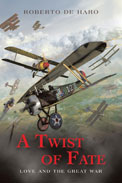
 |
At the foundation of this epic historical novel, which is also the first book of a trilogy, is a captivating love story for the ages. As the story begins, twenty-two-year-old Quentin Norvell, an American of Cajun ancestry from Louisiana, is wounded during a dogfight with a German pilot. A Princeton student with family ties to France, “the Cajun” has recently transferred to the French Air Service from the Foreign Legion. As he socializes with his French relatives and companions, he is introduced to Nadine Desnoyers, a strikingly graceful but married Frenchwoman of aristocratic background who is also a distant cousin of his best friend, Etienne, a French pilot.
Author de Haro skillfully meshes fact and fiction throughout the tale, and his career as a scholar no doubt supports this ability to craft historical fiction with both flair and accuracy. While the writing comes across as a bit uneven at times, it is more often masterful in description and clarity, as in this example: “The flight of French fighters appeared like specks on the horizon, and two of the planes stained the sky with trails of dark smoke that soon smudged the crisp blue sky and puffy white clouds…” The author’s literary spotlight never wavers from the love of country, the love of family, and the hopes and fears for personal survival and the future of humanity. The story engages all who enter the grand but fragile tapestry of human strength and frailty that marks conditions of war.
As the narrative wends its way in great detail through aerial battles and military and political concerns about the United States' entry into the Great War, it reveals the social and cultural lifestyles prevalent in upper-class France in the early twentieth century. Quentin’s status as a highly skilled American pilot flying for France makes him a perfect candidate for involvement in efforts by the British and French governments to entice the isolationist United States to enter the war. Recruited to this effort, he is also involved with the development and progression of aerial combat because of his expertise with aircraft and his natural concern for the fate of his fellow fighter pilots. With so many proverbial balls in the air for Quentin, his life is sometimes as dizzying as riding in the open cockpit of a WWI-era two-seater airplane.
The romantic liaison and the resulting complications that arise between Quentin and Nadine and the riveting aerial combat scenes are truly the novel’s best features, but those scenes sometimes feel lost between chapters depicting the historical background of the developing war. That said, the complicated plot and subplots deserve admiration because although there are many notable novels about the land war in World War I (such as the well-known classics All Quiet on the Western Front and A Farewell to Arms), few exist that concentrate on the aerial aspect of the Great War, and even fewer yet that are not crafted by British authors. Although the lengthy prognostication about America’s entry into the war is interesting and well-supported by factual references, it is the memorable characters in the personal throes of dramatic conflicts regarding love, life, survival, and death that enliven the story. Enthusiasts of epic historical novels will feel at home in this sweeping novel. Meanwhile, those who prefer immersion in more personal themes will revel in the high stakes of Quentin’s and Nadine’s steamy love affair and the heart-stopping aerial battles of World War I.
RECOMMENDED by the US Review